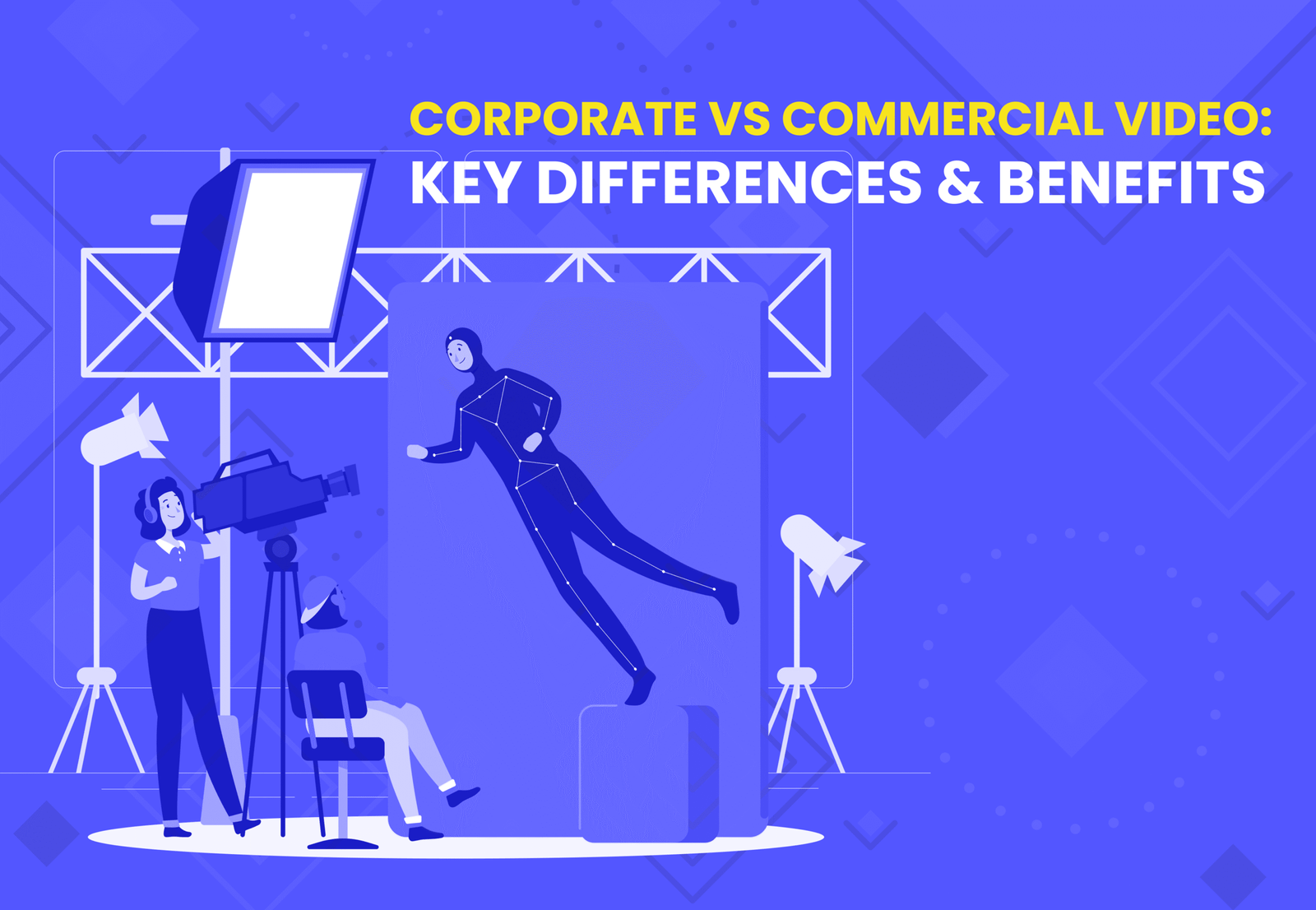
Choosing between corporate and commercial video production can shape how people see your brand. Both types make strong impressions, but they work in different ways. Corporate videos help share your company’s culture, train teams, and build trust with clients and employees. Commercial videos are quick, creative, and designed to spark action from potential customers.
Knowing the differences isn’t just helpful—it’s key for reaching your goals. If your video doesn’t match the audience or purpose, it’s easy to miss the mark. In this guide on corporate vs commercial video production, you’ll find out what really sets these formats apart and why it matters for your business. You’ll also see how making the right choice can help your brand stand out and connect with the people who matter most.
For more on who’s leading the way with business-focused content, check out these top corporate video production companies. And if you’re considering agencies that specialize in attention-grabbing campaigns, you might be interested in the Top Video Marketing Agencies making a difference in 2024.
Understanding the real difference between corporate and commercial videos helps you get more out of your content, time, and budget. Both play vital roles in your marketing or communication toolkit, but each targets a different audience and purpose. Here’s how they stand apart in function and form.

Corporate video production focuses on developing video content for organizations—whether internal or outward focused, but not directly promotional in nature. These videos keep employees informed, strengthen workplace culture, and help tell the story of your brand without chasing quick sales.
Some common forms of corporate video include:
Industry trends show a rise in remote video testimonials, explainer videos, and high-quality training modules. As more businesses rely on remote and hybrid teams, the demand for interactive, shareable internal content has grown. To see how companies are adapting on a larger scale, check out how enterprise video production services can elevate brand communication across departments or with stakeholders.
Typical characteristics of corporate video production:
If you want a deeper dive on how this medium supports positive public perception, the corporate film entry on Wikipedia outlines more examples and use cases.
Commercial video production is all about public attention and driving action. Think of commercials on TV, fast-paced digital ads, social media clips, or YouTube pre-rolls. The goal is simple: spark curiosity, prompt a purchase, and build product awareness—often within 15 to 60 seconds.
This format thrives on punchy storytelling, crisp visuals, and memorable taglines. Common commercial video types include:
Animated content, in particular, is gaining attention for its versatility and ability to connect with various audiences. If you're exploring how animation can make your campaigns stand out, take a look at why more marketers are turning to animated video solutions for business growth.
Hallmarks of commercial video production:
Commercial videos might use humor, drama, or surprise, but their main objective is measurable engagement, whether that’s shares, leads, or sales. These distinctions make it clear how “Corporate vs Commercial Video Production” isn’t just a matter of format, but of strategy and outcome.
For more on how businesses are using different videos for brand building or sales, explore additional insights at the Riverside blog on corporate video production.
When you compare corporate vs commercial video production, the differences go deeper than just the style of video or where it’s shown. Each serves a unique need, uses different creative strategies, and meets goals that support business growth in opposite but complementary ways. Let’s break down how these two video approaches stand apart—so you can match the right type to your brand’s ambitions.
Corporate videos are the glue behind the scenes. They focus on internal communication, training, or highlighting core values. Their mission is clear: build understanding, foster company pride, and keep teams aligned. For example, a CEO’s company address boosts morale, while a training video helps new hires settle in quickly. Every frame is designed to support long-term trust and knowledge sharing within the organization.
Commercial videos, by contrast, are all about spark and sizzle. Their objective? Reach the largest possible audience—and inspire immediate action. Whether it’s to buy, click, share, or sign up, these videos live or die by public attention. The messaging is bold, and the call to action is front and center. Think of those fast-paced ads on YouTube or emotional TV spots that stick with you well after the credits roll.
If you want a deeper dive into how goals and strategy shape these video types, the Difference Between Commercial Video & Corporate Video Production article spells out how purpose impacts every production decision.

Style is where the creative split really shows. Corporate videos use a straightforward approach, aiming for clarity and authenticity over flashy effects. They’re often longer, presenting information through interviews, testimonials, explainer animations, or guided walkthroughs. The storytelling is steady and grounded—think of it as giving viewers a seat at the table to see how your business works.
On the commercial side, creativity knows no bounds. These productions use every trick in the book to catch your eye: bold graphics, catchy soundtracks, quick edits, humor, and even outlandish storylines. The production value is high, but runtime is tight—usually under a minute. Commercials are there to entertain as much as inform, often using metaphors or memorable visuals so the viewer will remember the product.
Corporate video production targets a select crowd—mainly internal teams, stakeholders, or clients. You won't see these videos on public channels; instead, they’re showcased at events, uploaded to company portals, or shared during onboarding or presentations. The content must make sense and deliver value even if only a small group ever sees it.
Commercial videos, by contrast, go straight to the public. They appear wherever your audience is—broadcast TV, social media feeds, websites, YouTube, or as digital ads. The goal is reach. These videos are designed to stand out in busy feeds and connect with potential customers wherever they spend their time.
Here’s a quick look at the usual channels for both:
For more insight on how channels and audience shape success, check this breakdown of Corporate Video Production vs. Commercial Production in the USA.
Whether you want to strengthen internal connections or ignite action in the market, it all starts with knowing which approach fits your goals. Corporate vs Commercial Video Production is a question of purpose, style, and how far you want your story to travel.
Every brand’s messaging is different—and so are the goals that shape your video projects. Whether you’re considering a corporate video to build internal trust or a commercial spot to grab new customers, making the right choice starts with purpose and planning. It’s not just about the type of video; it’s about picking a solution that matches your business priorities, fits your budget, and delivers results.

Before you put resources into video, get clear on your business objectives. What do you want the video to achieve? Corporate vs Commercial Video Production isn’t a buzzword debate—it’s a real choice about getting results that matter for your team or your buyers.
Start with a goals checklist:
When a company like HubSpot wants to help new users get started, they use a range of onboarding and feature tutorial videos—a classic corporate video approach. Meanwhile, brands like Apple use flashy commercials to drive immediate global excitement for a product launch.
For more hands-on tips about defining these goals and matching your strategy, the 10 tips for creating an online video strategy for your business provides solid advice that works for companies of all sizes.
Your main takeaway: Let your objectives make the choice. When you’re clear on the result you want, it’s easier to decide if you need information-rich corporate content or the visual punch of a commercial campaign.
Corporate vs Commercial Video Production won’t look the same on your spreadsheet. Each format comes with different spending patterns, schedules, and measurements for success—but there are smart ways to maximize every dollar.
Corporate Videos:
Commercial Videos:
To make the most of your spend:
Smart planning and clear business goals reduce the risk of overspending or missing the mark. For step-by-step guidance on balancing cost, production time, and outcomes, take a look at these how-to steps for your video marketing strategy.
Video isn’t one-size-fits-all—make each investment count by starting with goals, knowing your numbers, and measuring what matters most.
The world of corporate vs commercial video production keeps shifting as technology raises the bar for what’s possible. Businesses today aren’t just keeping up—they’re setting creative new standards. Video content is moving beyond the basics, blending animation, interactive features, and smart personalization to keep both employees and customers hooked. What does this mean for the future? Let’s see where tech is taking videos businesses use every day and how innovators in the field are shaking up expectations.

Tomorrow’s business videos look and feel different from yesterday’s. Growing trends are bridging the gap between what works for internal teams (corporate) and what grabs outsiders’ attention (commercial). Rapid change means video producers must get creative, sharper, and more strategic. Here are some standout shifts happening right now:
Across the board, attention spans remain short. Micro-videos, social-ready edits, and live-streaming events are gaining in popularity as companies adjust their strategy for fast consumption and real-time response. For a solid overview on where tech meets creative production, see this expert breakdown of emerging corporate video trends.
It’s also worth tracking the ongoing evolution of animation to understand how classic hand-drawn work and new computer graphics are blending inside today’s business videos.
The future of corporate vs commercial video production is being shaped by companies that aren’t afraid to test boundaries. Real-world examples highlight what’s working—and show how bold decision-making can set new standards.
Corporate Innovators:
Commercial Leaders:
Hybrid Approach:
Some brands blur the line between corporate and commercial trends. Salesforce turns client success stories into animated case videos, doubling as internal inspiration and outward-facing proof of results. HubSpot creates live and animated content for both marketing and user onboarding, all centered on engagement and fast feedback.
Why do these matter for your business? They teach us that future-ready video means balancing education with entertainment. Whether you’re building culture inside your team or reaching customers outside, combining technology, smart storytelling, and a willingness to try new formats is the path to better results.
For businesses eager to adapt, see how today’s best brands increase brand awareness with video marketing. The companies that thrive next year will be those who aren’t afraid to produce videos that inform, excite, and include every viewer.
Looking for even more insight? Find a comprehensive look ahead on how video production trends are changing in 2025 and see firsthand which tactics carry real impact in a crowded market.
Choosing between corporate and commercial video production comes down to understanding your goals and the audience you want to reach. Corporate videos act as the backbone for internal growth, supporting communication and culture. Commercial videos spark customer action and give products a spotlight.
Successful businesses know when to use each type for maximum impact. Clear strategy, planning, and creative execution ensure these videos drive real results—from developing strong teams to boosting brand awareness and sales. By recognizing the benefits of both, you can make smarter choices that build trust and support business growth.
Ready to explore ways to integrate both for a stronger brand presence? See how video marketing can boost ecommerce sales and open new doors for business or dive into Corporate Video Production in Bangalore for examples of successful campaigns. Thank you for reading—feel free to share your experiences or questions in the comments.
Stand Out with Stunning Animation!